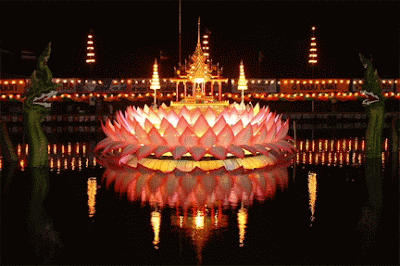On the full moon night of the 12th lunar month, the tide in the rivers is highest and the moon at its brightest, creating a romantic setting ideal for lovers. The Thai people choose this day to hold the ‘Loy Kratong’ festival, or the ‘festival of light.’ Loy Kratong is one of the two most recognized festivals in the country.
 Loy Kratong is probably the most picturesque and beautiful of all Thai celebrations. ‘Loy’ literally means ‘to float,’ while ‘kratong’ refers to the lotus-shaped receptacle which can float on the water. Originally, the kratong was made of banana leaves or the layers of the trunk of a banana tree or a spider lily plant. A kratong contains food, betel nuts, flowers, joss sticks, candle and coins. The making of a kratong is much more creative these days as many more materials are available.
Loy Kratong is probably the most picturesque and beautiful of all Thai celebrations. ‘Loy’ literally means ‘to float,’ while ‘kratong’ refers to the lotus-shaped receptacle which can float on the water. Originally, the kratong was made of banana leaves or the layers of the trunk of a banana tree or a spider lily plant. A kratong contains food, betel nuts, flowers, joss sticks, candle and coins. The making of a kratong is much more creative these days as many more materials are available.
The Loy Kratong ritual is a simple one. One needs only to light the candles and the joss sticks, make one’s wishes and let it float away with the current of a river or a canal.
On that day, thousands of people will gather beside the canals and rivers. With kratong in hands, they light the candle, put some coins in the kratong and silently make a wish, and carefully place their kratongs in the water and release them to the current.
They watch intently as the float drifts silently downstream, hoping that the candle will not go out. Its flame is said to signify longevity, fulfillment of wishes and release from sins. Altogether it is considered a romantic night for couples or lovers. Couples who make a wish together on Loy Kratong are thought to stay together in the future.
The Origins of Loy Krathong
Different legends surround the origins of Loy Kratong. The most popular version is it was an expression of gratitude to the goddess of water ‘Phra Mae Kongka’ for having extensively used, and sometimes polluted, the water from the rivers and canals. It is also in part a thanksgiving for her bounty in providing water for the livelihood of the people.
Some believe the festival originates from Buddhism. They say the offering of flowers, candles and joss-sticks is a tribute of respect to the footprint of the Lord Buddha on the sandy beach of the Narmaha River in India, as well as to the great Serpent and dwellers of the underwater world, after the Lord Buddha’s visit to their watery realm. It is possible that this is derived from a Hindu festival that pays tribute to the god Vishnu, who meditates at the center of the ocean.
 Others believe that the floral kratong is offered to the pagoda containing the Lord Buddha’s topknot, which was cut off at his self-ordination and is now in heaven. Another explanation is that it is a way to pay respect to one’s ancestors.
Others believe that the floral kratong is offered to the pagoda containing the Lord Buddha’s topknot, which was cut off at his self-ordination and is now in heaven. Another explanation is that it is a way to pay respect to one’s ancestors.
Whatever the true origin, the practice of Loy Kratong first began in the ancient kingdom of Sukhothai in the 13th century. A young queen named Nang Noppamas was believed to be the one who made a small boat laden with candles and incense and floated it down the river. The name Nang Noppamas has been associated with Loy Kratong ever since.
Today, Loy Kratong offers a unique occasion to celebrate. It’s a good time for people to make wishes and look to the future as they float their floral offerings along the waterways.
Where to celebrate
Although celebrated nationwide, Loy Kratong is particularly delightful in the provinces of Sukhothai, Chiang Mai, Ayutthaya and Bangkok.
As the place of origin of the festival, Sukhothai rightly remains the focal point of the celebrations. The festival comes with a spectacular light-and-sound show held in the ancient and traditional setting of the Sukhothai historical park.
 Chiang Mai is another prime site to celebrate Loy Kratong. The festival is known in northern dialect as ‘Yi Peng.’ The largest kratongs are decorated floats, paraded through the town on trucks. The colorfully lit floats form a long glittering parade as they make their way to the river.
Chiang Mai is another prime site to celebrate Loy Kratong. The festival is known in northern dialect as ‘Yi Peng.’ The largest kratongs are decorated floats, paraded through the town on trucks. The colorfully lit floats form a long glittering parade as they make their way to the river.
Meanwhile, up above thousands of ‘khom loy’ (floating lanterns) drift into the night sky. These large balloon-like lanterns are released at temples and sometimes from private homes in the hope that misfortune flies away with them.
The Chao Phraya River is one of the main waterways to celebrate the Loy Kratong festival. In Bangkok, riverside hotels organize special celebrations for their guests. In some hotels, swimming pools are turned into a temporary river for the Loy Kratong celebration.
Where to Enjoy Loy Krathong in Phuket?
Loy Krathong is celebrated nationwide. In Phuket, major hotels usually host a special evening so that guests can join in.
 Guests usually set the kratongs on the sea – a delightful scene as thousands of candlelit kratongs bob on the waves. In places like Patong, little boys will volunteer for a small fee to carry your kratong out a little further for a more auspicious start.
Guests usually set the kratongs on the sea – a delightful scene as thousands of candlelit kratongs bob on the waves. In places like Patong, little boys will volunteer for a small fee to carry your kratong out a little further for a more auspicious start.
All of Phuket’s major west coast beaches take part in Loy Kratong festivities, with a mix of locals and tourists. Nai Harn Lake and Patong Beach usually have the most activity with locals visiting beaches like Kata and Karon.
Two sites in Phuket Town: Saphan Hin Park and Suan Luang (King Rama IX) Park, are also popular places for locals to celebrate. Expect big crowds at both of these locations.
Loy Krathong 2010
Date : 21st November 2010
Venue: Nationwide

 Nowhere in Thailand is the vegetarian festival more colorful, exciting, and memorable than in Phuket. The origins of this Thailand festival itself can be traced to Chinese immigrants in Phuket. In the early 1800′s, Phuket was a major center of trade between China, India, and Southeast Asia. A large number of Chinese immigrants worked in tin mines and on rubber plantations. In 1825, a traveling Chinese opera visited Phuket to entertain the Chinese immigrants. At this time, the whole town became sick with malaria. The traveling opera paused to observe a strict vegetarian diet and the Chinese Nine Emperor Gods Festival. The traveling opera all recovered from the malaria, even though many people in Phuket died. The people of Phuket were so amazed that they continue to observe this Thai vegetarian festival each year along with the
Nowhere in Thailand is the vegetarian festival more colorful, exciting, and memorable than in Phuket. The origins of this Thailand festival itself can be traced to Chinese immigrants in Phuket. In the early 1800′s, Phuket was a major center of trade between China, India, and Southeast Asia. A large number of Chinese immigrants worked in tin mines and on rubber plantations. In 1825, a traveling Chinese opera visited Phuket to entertain the Chinese immigrants. At this time, the whole town became sick with malaria. The traveling opera paused to observe a strict vegetarian diet and the Chinese Nine Emperor Gods Festival. The traveling opera all recovered from the malaria, even though many people in Phuket died. The people of Phuket were so amazed that they continue to observe this Thai vegetarian festival each year along with the  One of the most exciting aspects of the festival is the various, (and sometimes gruesome) ceremonies which are held to invoke the gods. Firewalking, body piercing and other acts of self mortification undertaken by participants acting as mediums of the gods, have become more spectacular and daring as each year goes by. Men and women puncture their cheeks with various items including knives, skewers and other household items. It is believed that the Chinese gods will protect such persons from harm, and little blood or scarring results from such mutilation acts. This is definitely not recommended for the feint hearted to witness.
One of the most exciting aspects of the festival is the various, (and sometimes gruesome) ceremonies which are held to invoke the gods. Firewalking, body piercing and other acts of self mortification undertaken by participants acting as mediums of the gods, have become more spectacular and daring as each year goes by. Men and women puncture their cheeks with various items including knives, skewers and other household items. It is believed that the Chinese gods will protect such persons from harm, and little blood or scarring results from such mutilation acts. This is definitely not recommended for the feint hearted to witness.





